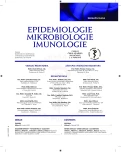Contribution of the detection of IgA antibodies to the laboratory diagnosis of mumps in the population with a high vaccination coverage
Authors:
R. Limberková 1; D. Smíšková 2; M. Havlíčková 1; K. Herrmannová 2; P. Lexová 1; M. Malý 1
Authors‘ workplace:
Státní zdravotní ústav, Centrum epidemiologie a mikrobiologie, Praha
1; Klinika infekčních, parazitárních a tropických nemocí, Nemocnice Na Bulovce, Praha
2
Published in:
Epidemiol. Mikrobiol. Imunol. 64, 2015, č. 1, s. 16-19
Category:
Review articles, original papers, case report
Overview
Study objective:
Serological diagnosis of epidemic mumps can be difficult in vaccinated persons, particularly due to the absence of specific IgM antibodies. The aim was to find whether adding the detection of IgA antibodies to the currently used routine serological diagnosis of mumps (detection of IgM and IgG antibodies in an acute serum sample) would make the serological diagnosis of mumps more effective in a population with a high vaccination coverage. At the same time, ELISA kits for the detection of early IgA and IgM antibodies against the mumps virus were compared and statistical analysis of the results was performed.
Material and methods:
Sixty-four acute sera from patients with laboratory confirmed diagnosis of mumps were included in the study. Clinical specimens were collected at the onset of clinical symptoms. To test the sera, the MASTAZYME ELISA Mumps IgA kit (MAST DIAGNOSTICA, Germany) with the MASTSORB sorbent (RF and IgG) and Enzygnost Anti-Parotitis-Virus/IgM kit (Siemens, Germany) were used. A panel of 121 acute sera with no epidemiological link to mumps virus served as specificity controls for the IgA assay. The epidemiological data were derived from the EPIDAT system. The level of agreement was assessed using the McNemara test and Cohen's coefficient kappa. The Stata 9.2 software (Stata Corp LP, College Station, USA) was used for statistical analysis.
Results:
The detection of IgA and IgM antibodies against the mumps virus yielded concordant results in 50/64 acute sera, 32 positive and 18 negative, i.e. an agreement of 78.12 %. Of the remaining 14 samples, 13 were only IgA positive and one was only IgM positive. The controls showed non-specific IgA positivity in 5/121 samples which indicates a 96% specificity.
Conclusion:
The absence of specific IgM antibodies against mumps virus is relatively often seen in vaccinated indivi-duals; nevertheless, the test is routinely used in patients with suspected active infection. The test for IgA antibodies, which is not routinely performed, significantly increased the detection rate of the disease. Based on the results of the present study, it can be concluded that the combination of the anti-mumps IgM and IgA assays increased the effectiveness of the serological diagnosis at the onset of clinical symptoms from less than 52% to nearly 72%.
KEYWORDS:
mumps virus – laboratory diagnosis – detection of IgA and IgM antibodies – epidemiology
Sources
1. Liebert UG. Viruses and pregnancy. Intervirology, 1998;41 : 145–148.
2. Petráš M, Lesná IK. Manuál očkování 2010. 3. vyd., Praha 2010;202–217 s. ISBN:978-80-254-5419-0.
3. Mrázová M, Smelhausová M, Sestáková Z, Svandová E, Benes C. The 2001 serological survey in the Czech Republic-mumps. Cent Eur J Public Health, 2003;11 Suppl.:S50–53.
4. Mauldin J, Carbone K, Hsu H, Yolken R, Rubin S. Mumps Virus--Specific Antibody Titers from Pre-vaccine era Sera: Comparison of the plaque Reduction Neutralization Assay and Enzyme Immunoassays. J Clin Microbio, 2005, p. 4847–4851, doi:10.1128/JCM.43.9.4847-4851.2005
5. MMWR May 22, 1998/47 (RR-8);s.1–57.
6. Decision No 2008/426/EC amending Decision No 2002/253/EC laying down case definitions for reporting communicable diseases to Community network under Decision No 2119/98/EC of European Parliament and of the Council.
7. Vyhláška č. 473/2008 Sb., o systému epidemiologické bdělosti pro vybrané infekce, ve znění pozdějších předpisů.
8. Laboratory testing for mumps infection. Dostupný na www: http://www.cdc.gov/mumps/lab/index.html.
9. Rota JS, Rosen JB, Doll MK et al. Comparison of the Sensitivity of Laboratory Diagnostic Methods from a Well-Characterized Outbreak of Mumps in New York City in 2009. Clin Vaccine Immunol, 2013;20(3):391–396.
10. Hořejší V, Bartůňková J. Základy imunologie. 3. vydání, Praha: Triton, 2008. 280 s. ISBN 80-7254-686-4.
11. Mühlemann K. The molecular epidemiology of mumps virus. Infect Genet Evol, 2004;4 : 215–219.
12. Briss PA, Fehrs LJ, Parker RA et al. Sustained transmission of mumps in a highly vaccinated population: assesment of primary vaccine failure and waning vaccine-induced imunity. J Infect Dis, 1994;169 : 77–82.
13. Kaaijk P, Zeijst BA, Boog MC, Hoitink CW. Increased mumps incidence in the Netherlands: Review on the possible role of vaccine strain and genotype. Euro Surveill, 2008;13(26):pii=18914. Dostupný na www: http://www.eurosurveillance.org/ViewArticle.aspx?ArticleId=18914.
14. Rubin SA, Qi L, Audet SA, Sullivan B et al. Antibody induced by immunization with the Jeryl Lynn mumps vaccine strain effectively neutralizes a heterologous wild-type mumps virus associated with a large outbreak. J Infect Dis, 2008;198(4):508–515. doi: 10.1086/590115
Labels
Hygiene and epidemiology Medical virology Clinical microbiologyArticle was published in
Epidemiology, Microbiology, Immunology

2015 Issue 1
Most read in this issue
- Macrolide resistance in Treponema pallidum subsp. pallidum in the Czech Republic and in other countries
- Contribution of the detection of IgA antibodies to the laboratory diagnosis of mumps in the population with a high vaccination coverage
- Minimum inhibitory concentrations of erythromycin and other antibiotics for Czech strains of Bordetella pertussis
- A case of tuberculous meningitis associated with persistently reduced CD4+ T lymphocyte counts
